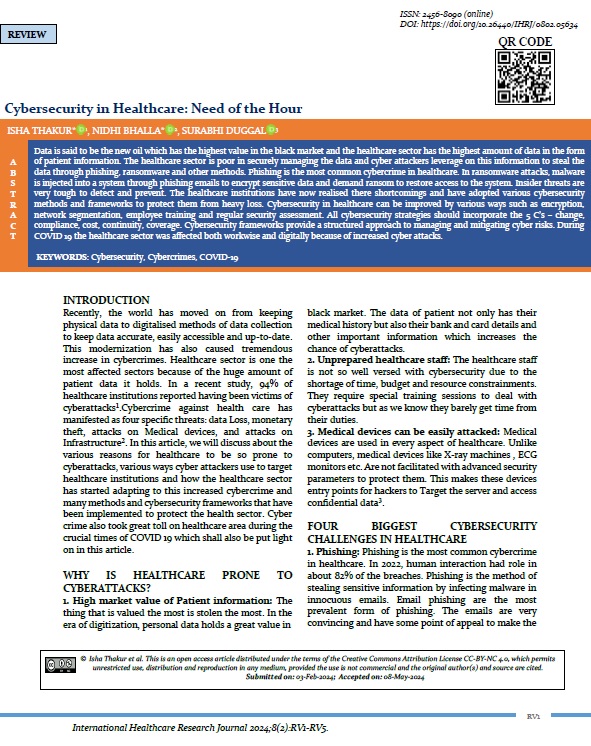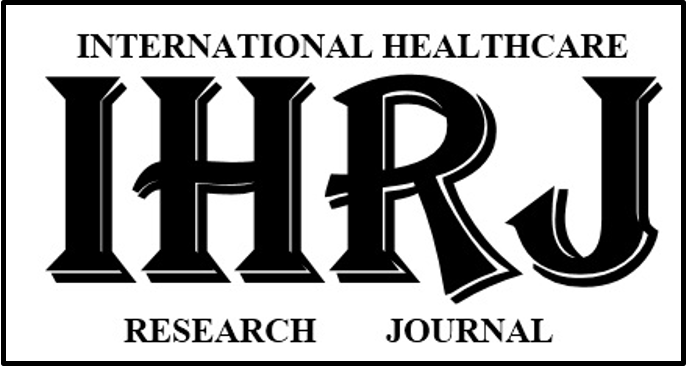Cybersecurity in Healthcare: Need of the Hour
Abstract
Data is said to be the new oil which has the highest value in the black market and the healthcare sector has the highest amount of data in the form of patient information. The healthcare sector is poor in securely managing the data and cyber attackers leverage on this information to steal the data through phishing, ransomware and other methods. Phishing is the most common cybercrime in healthcare. In ransomware attacks, malware is injected into a system through phishing emails to encrypt sensitive data and demand ransom to restore access to the system. Insider threats are very tough to detect and prevent. The healthcare institutions have now realised there shortcomings and have adopted various cybersecurity methods and frameworks to protect them from heavy loss. Cybersecurity in healthcare can be improved by various ways such as encryption, network segmentation, employee training and regular security assessment. All cybersecurity strategies should incorporate the 5 C’s – change, compliance, cost, continuity, coverage. Cybersecurity frameworks provide a structured approach to managing and mitigating cyber risks. During COVID 19 the healthcare sector was affected both workwise and digitally because of increased cyber attacks.
Downloads
References
Filkins B. Health care cyberthreat report: Widespread compromises detected, compliance nightmare on horizon paper. Available from: http://www.sans.org/reading-room/whitepapers/firewalls/paper/34735. [Last Accessed June 24th, 2023].
Jalali MS, Kaiser JP. Cybersecurity in Hospitals: A Systematic, Organizational Perspective. J Med Internet Res. 2018;20(5):e10059. https://doi.org/10.2196/10059.
Mejía-Granda CM, Fernández-Alemán JL, Carrillo-de-Gea JM, García-Berná JA. Security vulnerabilities in healthcare: an analysis of medical devices and software. Med Biol Eng Comput. 2024;62(1):257-73. https://doi.org/10.1007/s11517-023-02912-0.
Alawida M, Omolara AE, Abiodun OI, Al-Rajab M. A deeper look into cybersecurity issues in the wake of Covid-19: A survey. J King Saud Univ Comput Inf Sci. 2022;34(10):8176-8206. https://doi.org/10.1016/j.jksuci.2022.08.003.
He Y, Aliyu A, Evans M, Luo C. Health Care Cybersecurity Challenges and Solutions Under the Climate of COVID-19: Scoping Review. J Med Internet Res. 2021 Apr 20;23(4):e21747. doi: 10.2196/21747. Erratum in: J Med Internet Res. 2021;23(4):e29877.
Mathew A. The 5 Cs of Cybersecurity and its Integration with Predictive Analytics, International Journal of Computer Science and Mobile Computing 2023;12(1):47-50.
Taherdoost H. Understanding Cybersecurity Frameworks and Information Security Standards—A Review and Comprehensive Overview. Electronics. 2022; 11(14):2181. https://doi.org/10.3390/electronics11142181
Ignatovski M. Healthcare Breaches During COVID-19: The Effect of the Healthcare Entity Type on the Number of Impacted Individuals. Perspect Health Inf Manag. 2022;19(4):1c.

Copyright (c) 2024 Isha Thakur et al.

This work is licensed under a Creative Commons Attribution-NonCommercial 4.0 International License.


